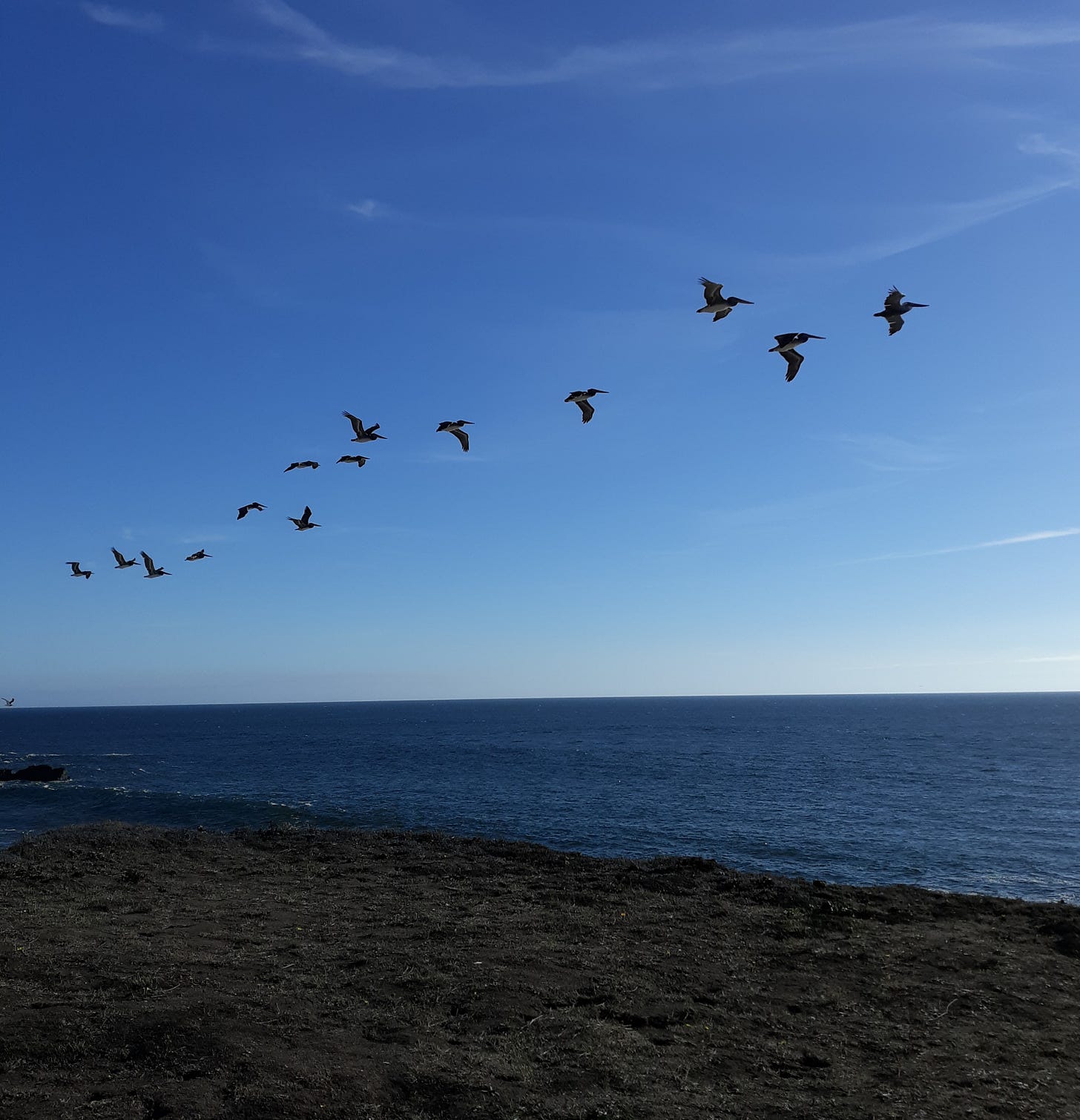Wings Without Borders
Rachel Carson on listening for the night bird migrators. Plus, the prehistoric pelican alters time.
You’re at Mother E, a free newsletter published every other Sunday. I’m telling the stories about our kinship and connections with other species in a climate-changing world. You can read more posts here. Did you miss the last one? Fat Bear Week— Foraging 20 Hours a Day
This week, I’ve written two short essays related to the autumn bird migration.
To subscribe to Mother E, sign up below.
The mystery of migrating birds in the night
RACHEL CARSON, THE FAMOUS BIOLOGIST and author of Silent Spring, lived on the coast of Maine in the mid-twentieth century. Her young nephew Roger stayed with her often and the two shared a passion for exploring and discovering. Her prose about the natural world still inspires.
She noted how autumn nights were a good time to listen for bird voices such as migrating geese and other long-distance travelers. “Take your child [or yourself] out on a still October night when there is little wind and find a quiet place away from traffic noises.”
“Then stand very still and listen, projecting your consciousness up into the dark arch of the sky above you. Presently your ears will detect tiny wisps of sound—sharp chirps, sibilant lisps and call notes. They are the voices of bird migrants, apparently keeping in touch by their calls with others of their kind scattered through the sky.
I never hear these calls without a wave of feeling that is compounded of many emotions—a sense of lonely distances, a compassionate awareness of small lives controlled and directed by forces beyond volition or denial, a surging wonder at the sure instinct for route and direction that has so far baffled human efforts to explain it.”
Rachel Carson, A Sense of Wonder
How has migration changed for birds since weather has grown more extreme?
Wings without borders
On invisible paths through arc of the sky
Flying a thousand miles or more
Ancient knowing tucked into feathery breast
Assailed by dark clouds, cold, winds
Ever pushing on
To join with the rest
In a miracle of movement
Robin A.
A descendent of dinosaurs travels the coasts
Watching lines of pelicans migrating is mesmerizing, leading to a new awareness of time.
MY WALKS ALONG THE COASTAL BLUFFS always offer something to observe. The last couple of months (late summer/ early fall) have seen an aerial flow of migrating birds, some heading south, such as geese, and some heading north. One of the groups going north is the Brown pelican (Pelecanus occidentalis), once on the endangered species list in the 1970s due to DDT insecticide.
Thankfully, their population has rebounded. I love to watch them in the air, with their distinctive profile and large 6 to 7-foot wingspan. To see them in flight is to witness grace, strength, and coordination. They flap their wings a handful of times, then glide. This conservation of energy allows them to fly hours at a time and up to 90 miles a day. Groups of flight mates seem to coordinate their wing flaps and glides, so they can be seen all sailing smoothly together. Their large shadows slide over the cliff bluffs as they wing their way north, probably to British Columbia following fish runs.
As they approach the Gualala River in Northern California where it joins the sea, they may wheel in a large sky circle before turning inland to the calm waters of the lagoon. Their stopover here provides rest, food, and a way to check in with each other. Flying is such a single-minded pursuit, they need a break.
After watching the pelican groups flying north for a quarter-hour or more, I often slip into a reverie. I’m on “pelican-time.” This is nothing more than feeling in sync with nature’s rhythms and patterns. These birds follow no clock, just the movement of the sun through the sky. There are no mealtimes, just eating when hungry and food is found. Pelicans have no known schedules beyond those deep promptings to breed and migrate seasonally. These birds have all the time in the world, and that includes time to just loaf on a riverbank or island, companionably grooming or dozing.
To some, “pelican time” might sound like a blessed opportunity to slip the bonds of a busy life and get back in touch with a deeper Earth pattern. You don’t even need pelicans. You can sit quietly and observe birds, or lie under a tree canopy to watch the leaves against the sky, or focus on a body of water. Everyone has their own preference for how to get grounded or in sync with Earth’s natural rhythms. These natural rhythms fit our body’s patterns and are more closely aligned with our 250,000+ year history of modern man on Earth, where we mostly lived aligned with nature.
What emerges from this gift of being on “pelican time”—this stillness? For me, it’s the ability to fully relax, clear the mind, and foster more awareness of what’s around me. For others, it could bring an increase in peace, creativity, freedom, even productivity. Whatever benefits it brings, it’s a welcome gift from the natural world and a reminder that slowing down can open up precious pauses for reflection.
Maybe one first step to solving the many man-made crises on Earth is to relearn how to be embedded with the natural world.
What’s your form of “pelican time?”
The video below is 1 minute 14 seconds (short Youtube ad first) and tells fun facts about pelicans.
Pelicans are a fascinating species that evolved from dinosaurs about 30 million years ago. To read more about their quirky habits, go here.
I love to hear from readers. Share your comments above, reply to this email to reach me privately, or contact me on Twitter @RobinApplegarth
Robin A.






A very reflective, meditative piece: one of your best! Plus a fine poem. Judy